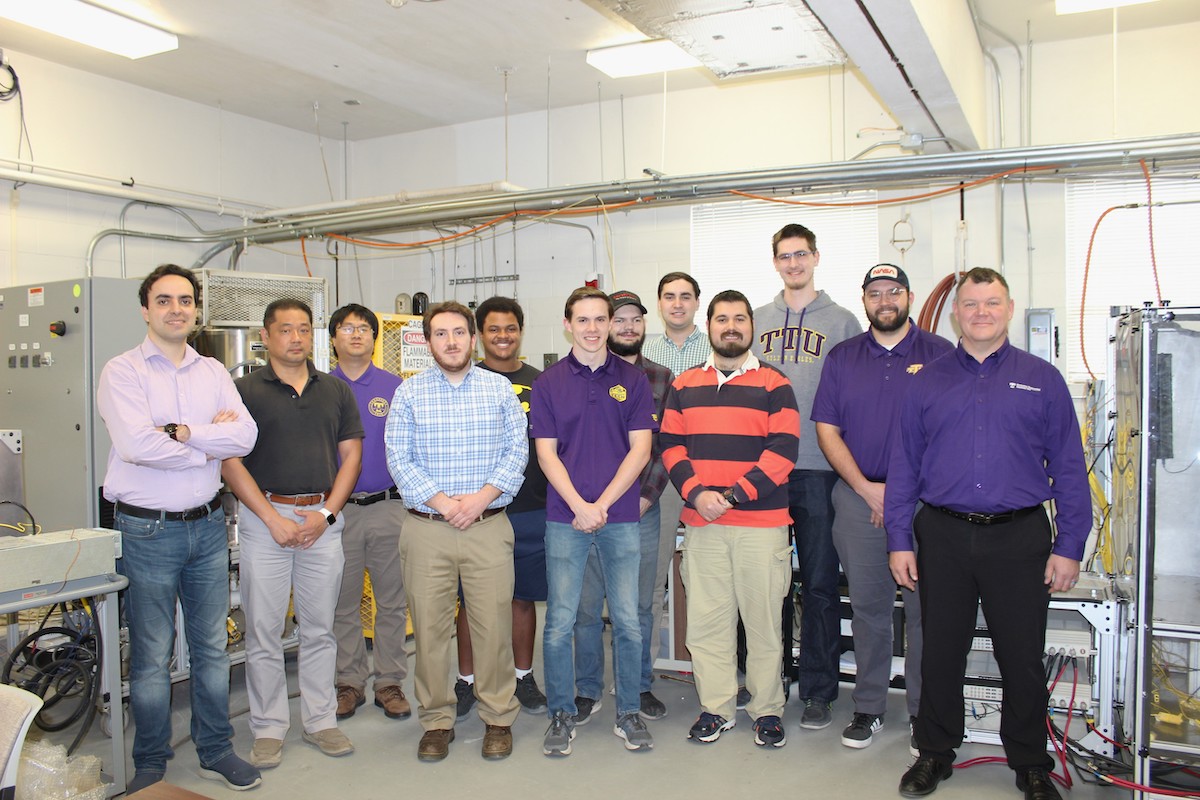NASA taps Tennessee Tech-led aerospace engineering research team to develop electric-powered commercial aircraft
Five universities and three companies will collaborate on NASA’s long-term goal of
zero-emission air travel while creating opportunity for aerospace workforce development
Tech faculty and student researchers are shown in the university’s Propulsion, Power,
and Thermal Systems Laboratory which will lead a team of seven additional universities
and industry partners in the CarbonLess Electric AviatioN (CLEAN) as part of NASA’s
University Leadership Initiative program. Left-to-right: Faculty members Ahmad Vaselbehagh,
Ph.D., Bruce Jo, Ph.D.; Research Engineer Mingyang Gong, Ph.D.; students, Aaron Bain,
Ph.D., Alex Tharpe, David Schafer, Jeff Webster, Jimmy Meacham, Andrew Ellicott, Ph.D.,
Noah Simpson, Trevor Kramer, Ph.D.; and lead investigator Rory Roberts, Ph.D.
NASA has selected Tennessee Tech University engineering researchers to lead a team
of universities and industry partners to help solve one of aviation’s key challenges
for the future of commercial air travel: zero-emission aircraft by 2050.
With an estimated budget of $8 million, the CarbonLess Electric AviatioN (CLEAN) project
is led by Rory Roberts, Ph.D., associate professor of mechanical engineering and head
of the Propulsion, Power and Thermal Systems Laboratory at Tech. He is joined by two
other Tech faculty members, Bruce Jo, Ph.D., associate professor of mechanical engineering
and Ahmad Vaselbehagh, Ph.D., assistant professor of mechanical engineering. Additional
team members include Tennessee State University, The Ohio State University, University
of Dayton, University of Washington – Bothell, Boeing Research & Technology, Raytheon
Technologies Research Center, and Special Power Sources.
NASA announced the funding last week under its University Leadership Initiative in
the agency’s Aeronautics Research Mission Directorate, which is in final negotiations
with teams for funding up to four years. “The University Leadership Initiative is
an integral part of our research portfolio,” said Bob Pearce, associate administrator
for the Aeronautics Research Mission Directorate at NASA Headquarters in Washington.
“The multidisciplinary teams are directly contributing to our priorities and even
leading the exploration of solutions beyond our current portfolio.”
Aerospace and aviation agencies and airlines around the globe have set an ambitious
goal of reaching net-zero emissions by 2050 to reduce the climate impact of commercial
air travel, requiring the development of next-generation aircraft. But electrifying
passenger planes like a Boeing 737 is very challenging, Roberts said.
“The energy needed for take-off alone is the electrical equivalent of powering 6,000
homes. There just isn’t going to be a battery that can do that, so you have to think
out of the box and start thinking about the entire aircraft and how to accomplish
that. Huge technological breakthroughs are needed across all these systems to develop
electric flight,” Roberts said.
That’s where CLEAN comes in. Roberts pulled together the CLEAN team of university
researchers with expertise in the various systems and components needed to start designing
an entire aircraft. They will specifically explore a preliminary design for an electrified,
150-passenger aircraft that uses an ammonia-based integrated propulsion, power, and
thermal management system.
“We’re at a point now where we can bring all this research together to design an aircraft,
with the goal of bringing it to market one day,” Roberts added.
The innovation the team and the University Leadership Initiative will bring to the
aerospace industry extends beyond technology to the education of a future workforce,
according to NASA.
“This multidisciplinary approach enables the lead teams to partner with others, including
student populations who are underrepresented or have not been involved before in aviation
research,” said Koushik Datta, University Leadership Initiative project manager. “As
we look to future growth in Advanced Air Mobility and an increasing emphasis on creating
truly sustainable aviation, it’s important we involve today’s students in helping
us solve tomorrow’s challenges.”
The CLEAN team will directly employ 98 undergraduate and graduate students as researchers
across the five universities, with 58 opportunities at Tech alone, according to Roberts.
That’s good news for Tech undergraduate students, as the aerospace concentration in
the mechanical engineering program is rapidly growing.
“Aerospace continues to expand in Tennessee and Tech is poised to support it,” said
Joseph C. Slater, dean of the College of Engineering at Tennessee Tech. “When federal
agencies invest in university-industry partnerships conducting innovative and disruptive
research, there is both a technological impact and workforce development impact. Our
students will learn the skills and future technologies the aerospace industry will
depend on as they develop next-generation aircraft, and that has enormous potential.”
To learn more about aerospace research at Tennessee Tech and to receive updates on
CLEAN, visit the Tennessee Tech Propulsion, Power, and Thermal Systems Laboratory
website: https://sites.tntech.edu/ppats/.
To learn more about Tennessee Tech College of Engineering’s aerospace program, visit: https://www.tntech.edu/engineering/programs/me/ve-conc-1.php.

